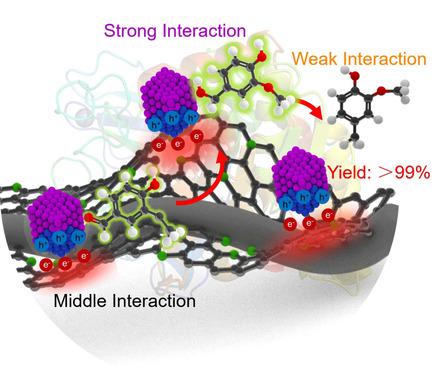当前位置:
X-MOL 学术
›
ChemSusChem
›
论文详情
Our official English website, www.x-mol.net, welcomes your
feedback! (Note: you will need to create a separate account there.)
Biomimetic Design of 3D Transition Metal/Carbon Dyad for One-Step Hydrodeoxygenation of Vanillin.
ChemSusChem ( IF 7.5 ) Pub Date : 2020-01-16 , DOI: 10.1002/cssc.201902937 Tian-Jian Zhao 1 , Jun-Jun Zhang 1 , Hong-Hui Wang 1 , Juan Su 1, 2 , Xin-Hao Li 1 , Jie-Sheng Chen 1
ChemSusChem ( IF 7.5 ) Pub Date : 2020-01-16 , DOI: 10.1002/cssc.201902937 Tian-Jian Zhao 1 , Jun-Jun Zhang 1 , Hong-Hui Wang 1 , Juan Su 1, 2 , Xin-Hao Li 1 , Jie-Sheng Chen 1
Affiliation

|
Enzyme catalysts always show the excellent catalytic selectivity, which is important in biochemistry, especially in catalytic synthesis and biopharming. This selectivity is achieved by combining the binding effect induced by the electrostatic effect of the enzyme to attract specific substrate and then pre-arranging the substrates inside the enzyme's pocket. Herein, we report a proof-of-concept application of an interfacial electrostatic field induced via constructing Schottky heterojunctions to mimic the electrostatic catalysis of enzyme. In combination with 3D structure, a transition metal/carbon dyad was designed via a nanoconfinement methods to successfully promote the differential binding effect and the space-induced organization of reaction intermediate (vanillyl alcohol) and improved a novel one-step hydrogenolysis route of vanillin for the production of 2-methoxy-4-methylphenol with remarkably high selectivity (> 99%).
中文翻译:

香草醛一步加氢脱氧的3D过渡金属/碳双仿生设计。
酶催化剂始终显示出优异的催化选择性,这在生物化学中,尤其是在催化合成和生物制药中非常重要。通过将酶的静电作用引起的结合作用结合起来以吸引特定的底物,然后将底物预先排列在酶的口袋中,可以实现这种选择性。在本文中,我们报告了通过构造肖特基异质结来模拟酶的静电催化作用而产生的界面静电场的概念验证应用。结合3D结构,
更新日期:2020-03-05
中文翻译:

香草醛一步加氢脱氧的3D过渡金属/碳双仿生设计。
酶催化剂始终显示出优异的催化选择性,这在生物化学中,尤其是在催化合成和生物制药中非常重要。通过将酶的静电作用引起的结合作用结合起来以吸引特定的底物,然后将底物预先排列在酶的口袋中,可以实现这种选择性。在本文中,我们报告了通过构造肖特基异质结来模拟酶的静电催化作用而产生的界面静电场的概念验证应用。结合3D结构,











































 京公网安备 11010802027423号
京公网安备 11010802027423号